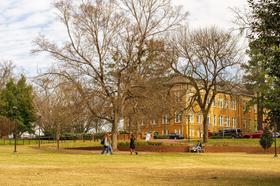For the 2025-26 school year, there are 6 alternative public high schools serving 962 students in Virginia.
The top ranked alternative public high schools in Virginia are Richmond Alternative, Bryant High School and Yvonne B. Miller High School. Overall testing rank is based on a school's combined math and reading proficiency test score ranking.
Virginia alternative public high schools have an average math proficiency score of 36% (versus the Virginia public high school average of 68%), and reading proficiency score of 72% (versus the 81% statewide average).
Virginia alternative public high school have a Graduation Rate of 20%, which is less than the Virginia average of 89%.
The school with highest graduation rate is Bryant High School, with 25-29% graduation rate. Read more about public school graduation rate statistics in Virginia or national school graduation rate statistics.
Minority enrollment is 85% of the student body (majority Hispanic), which is more than the Virginia public high school average of 55% (majority Black and Hispanic).
Best Alternative Public High Schools in Virginia (2025-26)
School
(Math and Reading Proficiency)
(Math and Reading Proficiency)
Location
Quick Facts
Rank: #11.
Richmond Alternative
Alternative School
(Math: 6-9% | Reading: 82%)
Rank:
Rank:
4/
Bottom 50%10
119 West Leigh Street
Richmond, VA 23220
(804) 780-4388
Richmond, VA 23220
(804) 780-4388
Gr: 6-12 | 134 students Student-teacher ratio: 27:1
Rank: #22.
Bryant High School
Alternative School
(Math: 50-59% | Reading: 60-69%)
Rank:
Rank:
3/
Bottom 50%10
2709 Popkins Ln
Alexandria, VA 22306
(703) 660-2001
Alexandria, VA 22306
(703) 660-2001
Gr: 9-12 | 159 students Student-teacher ratio: 9:1 Minority enrollment: 91%
Rank: #33.
Yvonne B. Miller High School
Alternative School
(Math: <50% | Reading: 21-39% )
Rank:
Rank:
2/
Bottom 50%10
600 E. Main Street, Floor 20
Richmond, VA 23219
(804) 371-0700
Richmond, VA 23219
(804) 371-0700
Gr: 6-12
Rank: #44.
Mountain View High School
Alternative School
(Math: 50-59% | Reading: 50-59%)
Rank:
Rank:
2/
Bottom 50%10
5775 Spindle Ct
Centreville, VA 20121
(703) 227-2316
Centreville, VA 20121
(703) 227-2316
Gr: 9-12 | 142 students Student-teacher ratio: 7:1 Minority enrollment: 87%
Rank: #55.
Carver College And Career Academy
Alternative School
(Math: 40-59% | Reading: 50-54%)
Rank:
Rank:
2/
Bottom 50%10
12400 Branders Bridge Road
Chester, VA 23831
(804) 768-6156
Chester, VA 23831
(804) 768-6156
Gr: 9-12 | 286 students Student-teacher ratio: 7:1 Minority enrollment: 69%
Rank: #66.
Fairfax County Adult High School
Alternative School
(Math: 50-59% | Reading: 40-44%)
Rank:
Rank:
2/
Bottom 50%10
6815 Edsall Rd, Suite 211
Springfield, VA 22151
(703) 658-2740
Springfield, VA 22151
(703) 658-2740
Gr: 9-12 | 241 students Student-teacher ratio: 19:1 Minority enrollment: 92%
Frequently Asked Questions
What are the top ranked alternative public high schools in Virginia?
The top ranked alternative public high schools in Virginia include Richmond Alternative, Bryant High School and Yvonne B. Miller High School.
How many alternative public high schools are located in Virginia?
6 alternative public high schools are located in Virginia.
What is the racial composition of students in Virginia?
Virginia alternative public high schools minority enrollment is 85% of the student body (majority Hispanic), which is more than the Virginia public high schools average of 55% (majority Black and Hispanic).
Recent Articles

School Vouchers 2025: Updated Pros and Cons
A 2025 update on school vouchers, including benefits, drawbacks, enrollment trends, and how vouchers affect public and private education.

The Role of Arts in Public Schools (2025 Update)
Explore why arts education remains vital in U.S. public schools, with updated data, new policy context, and insights for parents, students, and educators.

The Role of Sports in Public Schools in 2025
How sports in public schools shape learning, health, and community in 2025, with updated data, trends, and expert insights.
